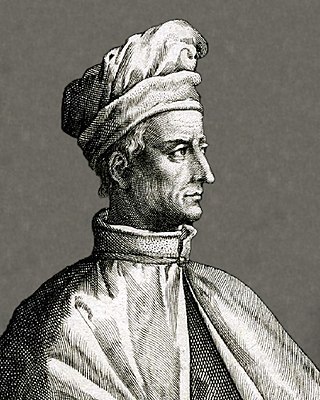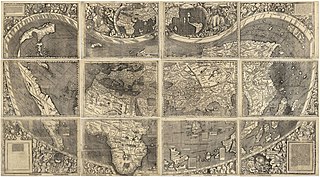Related Research Articles

Amerigo Vespucci was an Italian explorer and navigator from the Republic of Florence for whom "America" is named.

Christopher Columbus was an Italian explorer and navigator from the Republic of Genoa who completed four Spanish-based voyages across the Atlantic Ocean sponsored by the Catholic Monarchs, opening the way for the widespread European exploration and colonization of the Americas. His expeditions were the first known European contact with the Caribbean and Central and South America.
Year 1502 (MDII) was a common year starting on Saturday of the Julian calendar.

The history of the Kingdom of Portugal from the Illustrious Generation of the early 15th century to the fall of the House of Aviz in the late 16th century has been named the "Portuguese golden age" and the "Portuguese Renaissance". During this period, Portugal was the first European power to begin building a colonial empire as during the Age of Exploration Portuguese sailors and explorers discovered an eastern route to India as well as several Atlantic archipelagos and colonized the African coast and Brazil. They also explored the Indian Ocean and established trading routes throughout most of southern Asia, sending the first direct European maritime trade and diplomatic missions to Ming China and to Japan, at the same time installing trading posts and the most important colony: Portuguese Macau. The Portuguese Renaissance produced a plethora of poets, historians, critics, theologians, and moralists. The Cancioneiro Geral by Garcia de Resende is taken to mark the transition from Old Portuguese to the modern Portuguese language.

The Treaty of Tordesillas, signed in Tordesillas, Spain, on 7 June 1494, and ratified in Setúbal, Portugal, divided the newly discovered lands outside Europe between the Kingdom of Portugal and the Crown of Castile, along a meridian 600 kilometres (370 mi) west of the Cape Verde islands, off the west coast of Africa. That line of demarcation was about halfway between Cape Verde and the islands visited by Christopher Columbus on his first voyage, named in the treaty as Cipangu and Antillia.

Martin Behaim, also known as Martin von Behaim and by various forms of Martin of Bohemia, was a German textile merchant and cartographer. He served John II of Portugal as an adviser in matters of navigation and participated in a voyage to West Africa. He is now best known for his Erdapfel, the world's oldest known globe, which he produced for the Imperial City of Nuremberg in 1492.

Conquistadors or conquistadores is the term used to refer to Spanish and Portuguese soldiers and explorers who carried out the conquests and explorations of the Age of Discovery. Conquistadors sailed beyond the Iberian Peninsula to the Americas, Oceania, Africa and Asia, establishing new colonies and trade routes. They brought much of the "New World" under the dominion of Spain and Portugal.

Palos de la Frontera is a town and municipality located in the southwestern Spanish province of Huelva, in the autonomous community of Andalusia. It is situated some 13 km (8 mi) from the provincial capital, Huelva. According to the 2015 census, the city had a population of 10,365. It is most famous for being the place from which Columbus set sail in 1492, eventually reaching the Americas.

The Age of Discovery, also known as the Age of Exploration, was part of the early modern period and largely overlapped with the Age of Sail. It was a period from approximately the late 15th century to the 17th century, during which seafarers from a number of European countries explored, colonized, and conquered regions across the globe. The Age of Discovery was a transformative period in world history when previously isolated parts of the world became connected to form the world-system and laid the groundwork for globalization. The extensive overseas exploration, particularly the opening of maritime routes to the Indies and the European colonization of the Americas by the Spanish and Portuguese, later joined by the English, French and Dutch, spurred in the international global trade. The interconnected global economy of the 21st century has its origins in the expansion of trade networks during this era.

Antillia is a phantom island that was reputed, during the 15th-century age of exploration, to lie in the Atlantic Ocean, far to the west of Portugal and Spain. The island also went by the name of Isle of Seven Cities.

Juan de la Cosa was a Castilian navigator and cartographer, known for designing the earliest European world map which incorporated the territories of the Americas discovered in the 15th century. De la Cosa was the owner and master of the Santa María, and thus played an important role in the first and second voyage of Christopher Columbus to the West Indies.

La Santa María de la Inmaculada Concepción, or La Santa María, originally La Gallega, was the largest of the three small ships used by Christopher Columbus in his first expedition across the Atlantic Ocean in 1492, with the backing of the Spanish monarchs. Her master and owner was Juan de la Cosa.

Inter caetera was a papal bull issued by Pope Alexander VI on the 4 May 1493, which granted to the Catholic Monarchs King Ferdinand II of Aragon and Queen Isabella I of Castile all lands to the "west and south" of a pole-to-pole line 100 leagues west and south of any of the islands of the Azores or the Cape Verde islands.

The term "New World" is used to describe the majority of lands of Earth's Western Hemisphere, particularly the Americas. The term arose in the early 16th century during Europe's Age of Discovery, after Italian explorer Amerigo Vespucci published the Latin-language pamphlet Mundus Novus, presenting his conclusion that these lands constitute a new continent.

The Waldseemüller map or Universalis Cosmographia is a printed wall map of the world by German cartographer Martin Waldseemüller, originally published in April 1507. It is known as the first map to use the name "America". The name America is placed on South America on the main map. As explained in Cosmographiae Introductio, the name was bestowed in honor of the Italian Amerigo Vespucci.
The Johannes Schöner globes are a series of globes made by Johannes Schöner (1477–1547), the first being made in 1515. Schöner's globes are some of the oldest still in existence. Some of them are said by some authors to show parts of the world that were not yet known to Europeans, such as the Magellan Strait and the Antarctic.

The ethnic or national origin of explorer Christopher Columbus has been a source of speculation since the 19th century. The consensus among historians is that Columbus's family was from the coastal region of Liguria, that he was born and spent his boyhood and early youth in the Republic of Genoa, in Genoa, in Vico Diritto, and that he subsequently lived in Savona, where his father Domenico moved in 1470. Much evidence derives from documents concerning Columbus's immediate family connections in Genoa and opinions voiced by contemporaries on his Genoese origins, which few dispute.

Between 1492 and 1504, the Italian navigator and explorer Christopher Columbus led four transatlantic maritime expeditions in the name of the Catholic Monarchs of Spain to the Caribbean and to Central and South America. These voyages led to the widespread knowledge of the New World. This breakthrough inaugurated the period known as the Age of Discovery, which saw the colonization of the Americas, a related biological exchange, and trans-Atlantic trade. These events, the effects and consequences of which persist to the present, are often cited as the beginning of the modern era.

Portuguese maritime exploration resulted in the numerous territories and maritime routes recorded by the Portuguese as a result of their intensive maritime journeys during the 15th and 16th centuries. Portuguese sailors were at the vanguard of European exploration, chronicling and mapping the coasts of Africa and Asia, then known as the East Indies, and Canada and Brazil, in what came to be known as the Age of Discovery.

Beatriz Enríquez de Arana (1465–1521?) was the mother of Ferdinand Columbus, Christopher Columbus's younger son. The nature of her relationship to Christopher Columbus has been a subject of dispute amongst historians. Some evidence suggests that she was the second wife to Columbus. Other evidence suggests that Beatriz was the mistress of Columbus. It is important to note that Columbus himself referred to Beatriz as his wife and that social conventions at the time would likely have prevented Ferdinand Columbus from receiving his royal appointment to the court of Spain, if he were illegitimate. The Columbus family tree lists Ferdinand and Diego Columbus, Columbus's son from his first marriage, on the same branch, whereas illegitimate children are found to be separated in other parts of the tree.